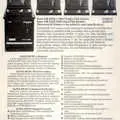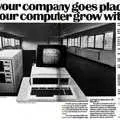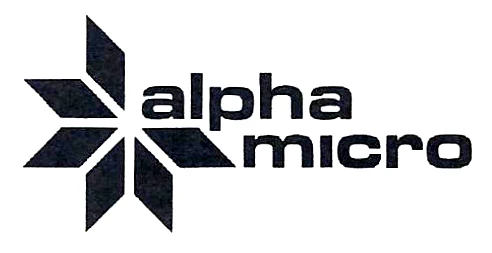
Alpha Micro Advert - January 1980
From Personal Computer World
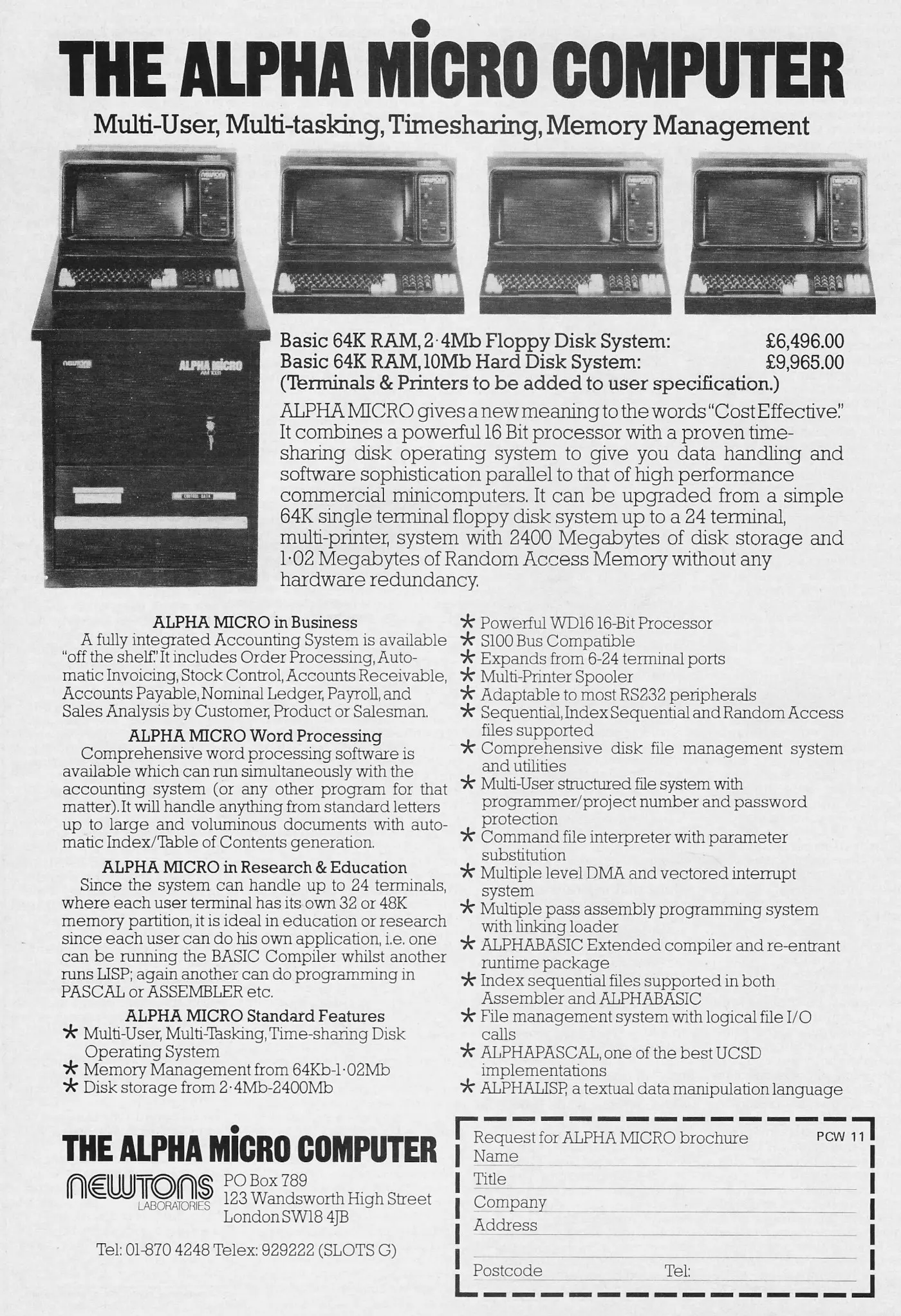
The Alpha Micro Computer: Multi-user, Multi-tasking, Timesharing, Memory Management
Alpha Microsystems Inc, more normally known as Alpha Micro, was founded in Costa Mesa, California, in 1977. The multi-user AM 100 series featured in the advert was its first microcomputer.
It was unusual in that it appears to be the only computer that ever shipped with a Western Digital WD16 16-bit processor as its main CPU.
Western Digital had started out as a disk/chip controller company, but got into actual hard disks - which it would ultimately become much more famous for - after it bought Tandon's Far East disk factory, when the latter company sold out for $80 million in order to fix its cash-flow problems[1].
Alpha Micro also sold a range of hard disk units, including its AM 400 and 500 fridge-sized hard-disk subsystems.
Its AM-500 used the CDC 9427H Hawk cartridge disk units with a capacity of 10MB - half of which was removable - whilst the AM-400 used Calcomp Trident drives with up to 300MB capacity - an enormous amount in 1978.
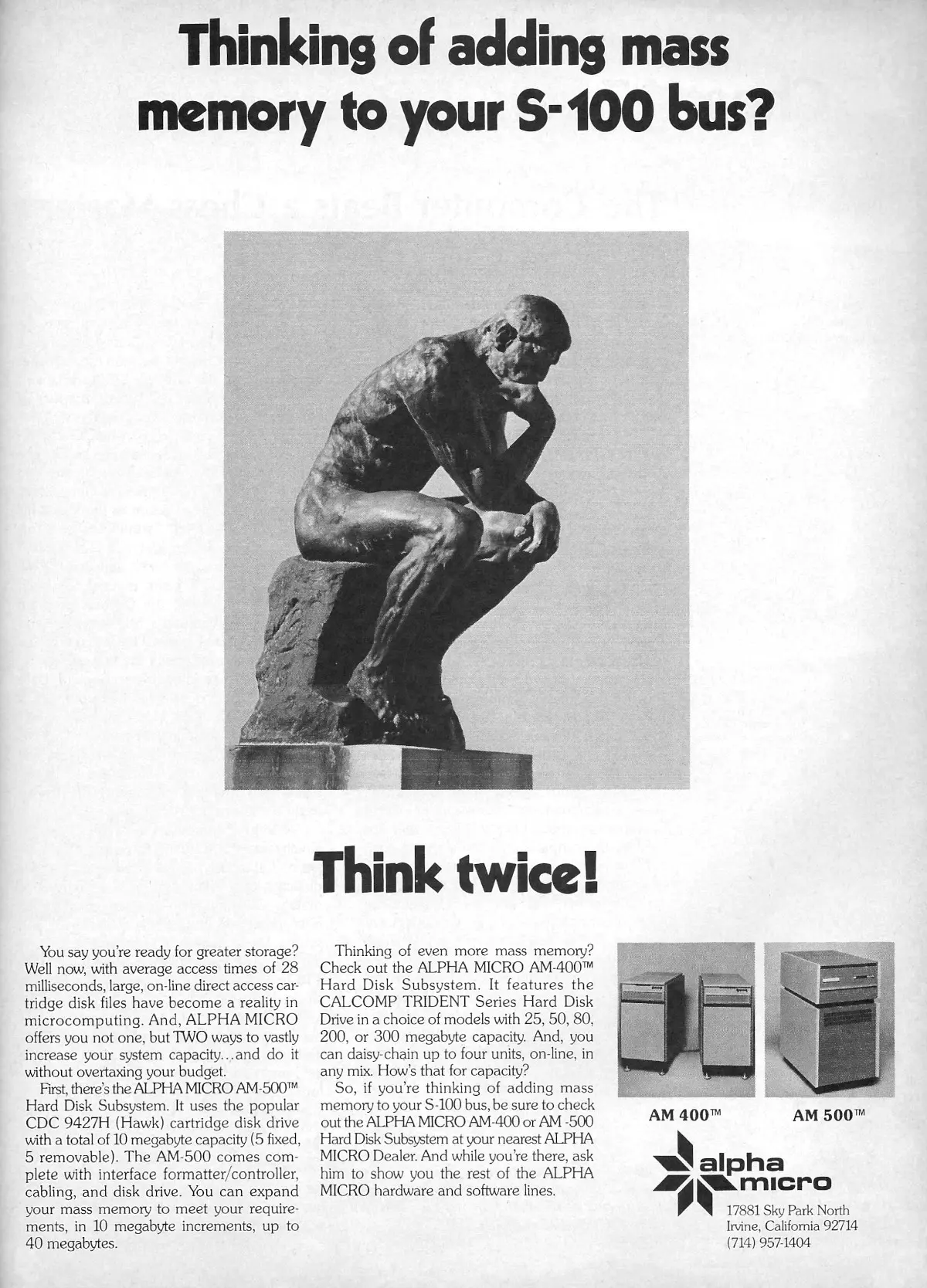
Alpha Micro's hard disk units. From Byte, December 1978
Meanwhile, the Alpha Micro machine ran its own time-sharing AMOS operating system, which was thought to have been heavily influenced by that of the DEC PDP-11 - so much so that DEC tried to sue in 1984[2].
It could support up to 24 terminals but, most impressively, could also support a total of up to 2.4 gigabytes of disk storage - a frankly stratospheric amount in 1980, where many business machines still operated on about 16K of system memory, and even in 1983 a 5MB drive for under £1,000 (£4,410 in 2025) was something to shout about.
However, it wasn't cheap: the basic machine with 64K RAM and a 10MB hard disk retailed for £9,965 - about £63,100 in 2025 money - with the 10MB Winchester representing a modest £3,500 (£22,100) premium over the floppy-disk system.
The Alpha Micro's S-100 bus, which had been made famous by MITS' Altair 8800 - where it was originally known simply as the Altair Bus - had been around since the end of 1974.
Once other micros cloned it - firstly in the IMSAI 8080 - it became a de-facto standard, but wasn't made official until 1983, by which time it was mostly obsolete.
The Europa E78 Bus
The idea of a "bus" was simply a standard way of extending a processor out in to some sort of shared hardware connection for the use of memory as well as plug-in cards like video adapters, laboratory I/O, or serial boards for talking to printers and modems. Some machines, like Ithaca's DSP-1 offered over 20 slots for this sort of purpose.
There were a few other bus standards around, in particular the fairly-popular and long-lived SS-50 bus first used by SWTPC's 6800 micro, but they were all tailored to a few specific processors. However in 1978 - as reported in May's Personal Computer World - they were joined by a challenger with a twist: the E78 bus, otherwise known as the Europa Bus.
It was developed for the popular Eurocard format that Acorn would base its Acorn Microcomputer/System 1 on just a few months later, but unlike the previous bus standards was not named prosaically after the number of connectors it used, but after the year it was launched.
It actually made use of 64 pins on either a 0.1" pitch 64-pin connector, where it was known as 64/64, or 64 pins on a 96-pin connector at 0.2" pitch, where it became the 64/96.
Many micros of the day, like Ohio's C3-B, were "multi-processor" in the sense that they actually had several different CPUs which could be switched in or out.
The novelty with E78[3] was that it claimed to allow Motorola, Intel and Texas Instruments' 8-bit and 16-bit processors to run simultaneously - a neat trick because different processors rarely, if ever, ran at exactly the same speed and all of them produced and required completely different signals.
At the time of its initial launch, the bus could only support Motorola's 6800 and Zilog's Z80, with other architectures coming later. The authors of the standard - Bob Cottis, Dave Howland and Pat Crowe - wrote about the almost direct compatibility with the Z80 that:
"Despite this similarity, it must be emphasized that this is not just intended to be a Z80 bus. The detailed logic has been worked out for the 6800 and Z80, and it has proved possible to make them sufficiently compatible that static memory cards and simple I/O can be directly interchangeable. The detailed logic for other processors has not yet been defined, as the authors of this standard do not have the first-hand knowledge necessary to define the control logic in the optimum way. We have however checked that the other processors can, as far as we are aware, be used with this bus structure without serious problems[4]".
Almost immediately, there was some negative feedback, with a letter published in the September 1978 edition of Personal Computer World listing several of the standard's perceived flaws.
These included potential issues with the multiplexed data buses of Intel's 8085 and 8086, the negative supply rails being too close to the logic lines on the bus itself, no apparent allowance being made for processors like the 6809 with its additional interrupt lines, and various issues with power supplies and physical size.
The letter, from Paul Borrill of the Department of Physics and Astronomy at UCL, concluding with a wary:
"I would very much like to see a pin allocations standard produced, but [with] a much more professional approach. In fact, several of my colleagues and I have already laid the groundwork for such a proposal which will be produced from the preferences and suggestions from a great deal of professional engineers, and after approval from all the actively interested parties an approach will be made to the British Standards Institution and the International Electrotechnical Committee for approval. I urge all potential users of the E78 standard to think carefully and keep closely in touch with professional circles who are likely to settle on a more useful standard shortly[5]".
The E78 standard was nevertheless published towards the end of 1979, thanks to inspiration and sponsorship of the Amateur Computer Club, where it seemed to have some traction[6]. Secretary of the E78 committee at the time, Alan Secker, said of the official launch that:
"in order to assist small would-be manufacturers in producing various E78-compatible components, I am setting up a register and will arrange to co-ordinate between them so as to arrange for most of the components to be available, and complete systems to come onto the market quickly"[7].
Perhaps inevitably, no subsequent mention or use of the E78 bus seems to have been made, anywhere.
Date created: 25 July 2013
Last updated: 26 August 2025
Hint: use left and right cursor keys to navigate between adverts.
Sources
Text and otherwise-uncredited photos © nosher.net 2025. Dollar/GBP conversions, where used, assume $1.50 to £1. "Now" prices are calculated dynamically using average RPI per year.
